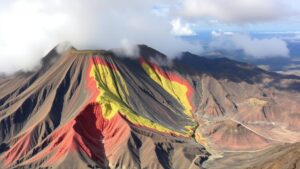Techniques for Detecting Gold in Volcanic-Hosted Massive Sulfide (VHMS) Deposits
Techniques for Detecting Gold in Volcanic-Hosted Massive Sulfide (VHMS) Deposits
Volcanic-Hosted Massive Sulfide (VHMS) deposits are significant sources of gold and other valuable minerals. Located in geologically active regions, these deposits are formed by the discharge of hydrothermal fluids from submarine volcanic systems. Detecting gold in VHMS deposits requires a combination of sophisticated techniques, which include geological, geophysical, and geochemical methods. This article provides an in-depth exploration of these techniques, grounded in real-world applications and case studies.
Geological Mapping and Sampling
Geological mapping is typically the first step in locating VHMS deposits. This process involves analyzing rock samples collected from various locations to identify mineralization patterns. Techniques often employed include:
- Outcrop Mapping: Geologists study exposed rock layers to identify the geological features associated with VHMS systems, such as volcanic rocks and sedimentary layers.
- Core Sampling: Drilling into the geological formations provides core samples, which reveal the structure and composition of subsurface materials, including the presence of sulfide minerals.
For example, the Yerington Mining District in Nevada employs comprehensive geological mapping to delineate zones of mineralization, helping in targeting specific drilling operations for gold extraction.
Geophysical Methods
Geophysical techniques are crucial for non-invasive exploration of VHMS deposits. e methods leverage physical properties of rocks to infer the presence of mineralized zones. Key geophysical techniques include:
- Electromagnetic (EM) Surveys: EM surveys help detect conductive sulfide minerals by measuring variations in the Earths electromagnetic field. The presence of massive sulfides can create distinct anomalies detectable from the surface.
- Gravity Surveys: Gravity surveys measure variations in the Earths gravitational field caused by the density contrast between mineralized zones and surrounding rocks. This method has proven effective in mapping VHMS deposits.
For example, the use of airborne EM surveys in the Red Sea region successfully identified several VHMS deposits, leading to more focused and effective drill projects.
Geochemical Analysis
Geochemical methods involve analyzing soil, rock, and water samples to detect trace elements indicative of gold presence. Techniques include:
- Stream Sediment Sampling: Collecting and analyzing sediments from nearby streams can reveal dispersal patterns of gold and associated elements, providing clues about potential deposits.
- Soil Geochemistry: Soil sampling and analysis for pathfinder elements (like arsenic, antimony, and copper) can indicate proximity to VHMS systems. High concentrations of these elements may suggest underlying mineralization.
The Gawler Craton in South Australia serves as a prime example where extensive geochemical surveys have led to significant discoveries of gold-rich VHMS deposits by analyzing stream sediment anomalies.
Integration of Remote Sensing Technology
The integration of remote sensing technology provides additional layers of data essential for detecting gold in VHMS deposits. Techniques include:
- Satellite Imagery: Satellites can capture wide areas to identify surface mineralization and alteration patterns, helping guide on-ground explorations.
- LiDAR (Light Detection and Ranging): This technology provides high-resolution topographical maps, allowing geologists to identify potential volcanic landforms associated with VHMS deposits.
In the Torres Strait region, remote sensing has been pivotal in mapping volcanic island features that correlate with potential VHMS mineralization.
Case Studies and Real-World Applications
Several successful case studies illustrate the efficacy of these detection techniques. One prominent example is the Flin Flon-Snow Lake region in Manitoba, Canada, where a combination of geochemical analysis, geological mapping, and geophysical surveys has led to the discovery of extensive VHMS deposits that are rich in copper and gold.
Another notable case is in the Pontide Orogenic belt of Turkey, where integrated geological and geophysical methods led to the identification of gold-rich VHMS deposits, significantly contributing to the countrys mineral wealth.
Conclusion
Detecting gold in Volcanic-Hosted Massive Sulfide deposits involves a multifaceted approach that combines geological, geophysical, and geochemical techniques. By integrating these methods, geologists can improve the accuracy of their explorations and enhance the likelihood of discovering economically viable deposits. As technology advances, particularly in remote sensing and data analysis, the prospects for discovering new VHMS deposits will continue to grow.
For those involved in mineral exploration, understanding and implementing these detection techniques is crucial. The synergy of traditional and modern approaches will be key to future discoveries in the field.



